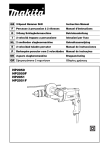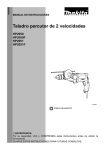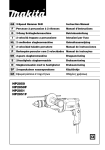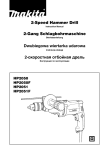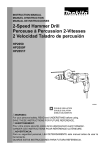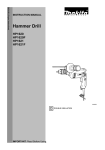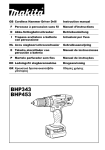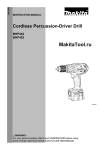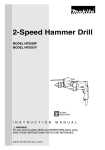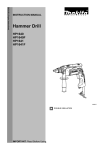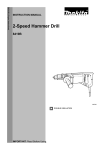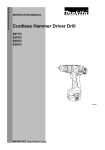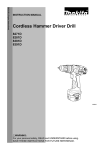Download Makita HP2051 Instruction manual
Transcript
ENGLISH (Original instructions) INSTRUCTION MANUAL 2-Speed Hammer Drill HP2050 HP2050F HP2051 HP2051F 002989 DOUBLE INSULATION WARNING: For your personal safety, READ and UNDERSTAND before using. SAVE THESE INSTRUCTIONS FOR FUTURE REFERENCE. 1 ENGLISH SPECIFICATIONS Model HP2050/HP2050F Speed Capacities HP2051/HP2051F High Low High Concrete 20 mm ----- 20 mm ----- Steel 8 mm 13 mm 8 mm 13 mm Wood Low 25 mm 40 mm 25 mm 40 mm No load speed (min-1) 0 - 2,900 0 - 1,200 0 - 2,900 0 - 1,200 Blows per minute 0 - 58,000 0 - 24,000 0 - 58,000 0 - 24,000 Overall length 362 mm Net weight 2.5 kg Safety class 360 mm 2.5 kg /II • Due to our continuing programme of research and development, the specifications herein are subject to change without notice. • Specifications may differ from country to country. • Weight according to EPTA-Procedure 01/2003 END201-5 Sound pressure level (LpA) : 97 dB(A) Sound power level (LWA) : 108 dB(A) Uncertainty (K) : 3 dB(A) Wear ear protection Symbols The following show the symbols used for the equipment. Be sure that you understand their meaning before use. ・ Read instruction manual. ・ DOUBLE INSULATION ・ Only for EU countries Do not dispose of electric equipment together with household waste material! In observance of European Directive 2002/96/EC on waste electric and electronic equipment and its implementation in accordance with national law, electric equipment that have reached the end of their life must be collected separately and returned to an environmentally compatible recycling facility. ENG203-2 Vibration The vibration total value (tri-axial vector determined according to EN60745: Work mode: impact drilling into concrete Vibration emission (ah,ID) : 13 m/s2 Uncertainty (K) : 3 m/s2 sum) ENG302-2 Work mode : drilling into metal Vibration emission (ah,D) : 2.5 m/s2 or less Uncertainty (K) : 1.5 m/s2 ENH101-12 EC Declaration of Conformity We Makita Corporation as the responsible manufacturer declare that the following Makita machine(s): Designation of Machine: 2-Speed Hammer Drill ENE039-1 Intended use The tool is intended for impact drilling in brick, concrete and stone as well as for drilling without impact in wood, metal, ceramic and plastic. Model No./ Type: HP2050,HP2050F,HP2051,HP2051F are of series production and Conforms to the following European Directives: 98/37/EC until 28th December 2009 and then with 2006/42/EC from 29th December 2009 And are manufactured in accordance with the following standards or standardised documents: EN60745 The technical documentation is kept by our authorised representative in Europe who is: Makita International Europe Ltd, Michigan, Drive, Tongwell, Milton Keynes, MK15 8JD, England ENF002-1 Power supply The tool should be connected only to a power supply of the same voltage as indicated on the nameplate, and can only be operated on single-phase AC supply. They are double-insulated in accordance with European Standard and can, therefore, also be used from sockets without earth wire. ENG102-2 For European countries only Noise The typical A-weighted noise level determined according to EN60745: 2 30th January 2009 8. When operating a power tool outdoors, use an extension cord suitable for outdoor use. Use of a cord suitable for outdoor use reduces the risk of electric shock. 9. If operating a power tool in a damp location is unavoidable, use a ground fault circuit interrupter (GFCI) protected supply. Use of an GFCI reduces the risk of electric shock. Personal safety 10. Stay alert, watch what you are doing and use common sense when operating a power tool. Do not use a power tool while you are tired or under the influence of drugs, alcohol or medication. A moment of inattention while operating power tools may result in serious personal injury. 11. Use personal protective equipment. Always wear eye protection. Protective equipment such as dust mask, non-skid safety shoes, hard hat, or hearing protection used for appropriate conditions will reduce personal injuries. 12. Prevent unintentional starting. Ensure the switch is in the off-position before connecting to power source and/or battery pack, picking up or carrying the tool. Carrying power tools with your finger on the switch or energising power tools that have the switch on invites accidents. 13. Remove any adjusting key or wrench before turning the power tool on. A wrench or a key left attached to a rotating part of the power tool may result in personal injury. 14. Do not overreach. Keep proper footing and balance at all times. This enables better control of the power tool in unexpected situations. 15. Dress properly. Do not wear loose clothing or jewellery. Keep your hair, clothing, and gloves away from moving parts. Loose clothes, jewellery or long hair can be caught in moving parts. 16. If devices are provided for the connection of dust extraction and collection facilities, ensure these are connected and properly used. Use of dust collection can reduce dust-related hazards. Power tool use and care 17. Do not force the power tool. Use the correct power tool for your application. The correct power tool will do the job better and safer at the rate for which it was designed. 18. Do not use the power tool if the switch does not turn it on and off. Any power tool that cannot be controlled with the switch is dangerous and must be repaired. 000230 Tomoyasu Kato Director Makita Corporation 3-11-8, Sumiyoshi-cho, Anjo, Aichi, JAPAN GEA005-2 General Power Tool Safety Warnings WARNING Read all safety warnings and all instructions. Failure to follow the warnings and instructions may result in electric shock, fire and/or serious injury. Save all warnings and instructions for future reference. The term "power tool" in the warnings refers to your mains-operated (corded) power tool or battery-operated (cordless) power tool. Work area safety 1. Keep work area clean and well lit. Cluttered or dark areas invite accidents. 2. Do not operate power tools in explosive atmospheres, such as in the presence of flammable liquids, gases or dust. Power tools create sparks which may ignite the dust or fumes. 3. Keep children and bystanders away while operating a power tool. Distractions can cause you to lose control. Electrical safety 4. Power tool plugs must match the outlet. Never modify the plug in any way. Do not use any adapter plugs with earthed (grounded) power tools. Unmodified plugs and matching outlets will reduce risk of electric shock. 5. Avoid body contact with earthed or grounded surfaces such as pipes, radiators, ranges and refrigerators. There is an increased risk of electric shock if your body is earthed or grounded. 6. Do not expose power tools to rain or wet conditions. Water entering a power tool will increase the risk of electric shock. 7. Do not abuse the cord. Never use the cord for carrying, pulling or unplugging the power tool. Keep cord away from heat, oil, sharp edges or moving parts. Damaged or entangled cords increase the risk of electric shock. 3 4. 19. Disconnect the plug from the power source and/or the battery pack from the power tool before making any adjustments, changing accessories, or storing power tools. Such preventive safety measures reduce the risk of starting the power tool accidentally. 20. Store idle power tools out of the reach of children and do not allow persons unfamiliar with the power tool or these instructions to operate the power tool. Power tools are dangerous in the hands of untrained users. 21. Maintain power tools. Check for misalignment or binding of moving parts, breakage of parts and any other condition that may affect the power tool’s operation. If damaged, have the power tool repaired before use. Many accidents are caused by poorly maintained power tools. 22. Keep cutting tools sharp and clean. Properly maintained cutting tools with sharp cutting edges are less likely to bind and are easier to control. 23. Use the power tool, accessories and tool bits etc. in accordance with these instructions, taking into account the working conditions and the work to be performed. Use of the power tool for operations different from those intended could result in a hazardous situation. Service 24. Have your power tool serviced by a qualified repair person using only identical replacement parts. This will ensure that the safety of the power tool is maintained. 25. Follow instruction for lubricating and changing accessories. 26. Keep handles dry, clean and free from oil and grease. Always be sure you have a firm footing. Be sure no one is below when using the tool in high locations. Hold the tool firmly with both hands. Keep hands away from rotating parts. Do not leave the tool running. Operate the tool only when hand-held. Do not touch the bit or the workpiece immediately after operation; they may be extremely hot and could burn your skin. Some material contains chemicals which may be toxic. Take caution to prevent dust inhalation and skin contact. Follow material supplier safety data. 5. 6. 7. 8. 9. SAVE THESE INSTRUCTIONS. WARNING: MISUSE or failure to follow the safety rules stated in this instruction manual may cause serious personal injury. FUNCTIONAL DESCRIPTION • CAUTION: Always be sure that the tool is switched off and unplugged before adjusting or checking function on the tool. Switch action 1 4 GEB003-4 3 SPECIFIC SAFETY RULES DO NOT let comfort or familiarity with product (gained from repeated use) replace strict adherence to hammer drill safety rules. If you use this power tool unsafely or incorrectly, you can suffer serious personal injury. 1. Wear ear protectors when impact drilling. Exposure to noise can cause hearing loss. 2. Use auxiliary handle(s), if supplied with the tool. Loss of control can cause personal injury. 3. Hold power tool by insulated gripping surfaces, when performing an operation where the cutting accessory may contact hidden wiring or its own cord. Cutting accessory contacting a "live" wire may make exposed metal parts of the power tool "live" and could give the operator an electric shock. 5 2 1. Lock button 2. Speed control screw 3. Switch trigger 4. Higher 5. Lower 002990 CAUTION: Before plugging in the tool, always check to see that the switch trigger actuates properly and returns to the "OFF" position when released. To start the tool, simply pull the switch trigger. Tool speed is increased by increasing pressure on the switch trigger. Release the switch trigger to stop. For continuous operation, pull the switch trigger and then push in the lock button. To stop the tool from the locked position, pull the switch trigger fully, then release it. A speed control screw is provided so that maximum tool speed can be limited (variable). Turn the speed control screw clockwise for higher speed, and counterclockwise • 4 Speed change for lower speed. Lighting up the lamps 1. Arrow 2. Speed change knob 1 For Model HP2050F, HP2051F 1. Lamp 2 002691 1 Two speed ranges can be preselected with the speed change knob. To change the speed, turn the speed change knob so that the arrow on the tool body points toward the "I" position on the knob for low speed or "II" position for high speed. If it is hard to turn the knob, first turn the chuck slightly in either direction and then turn the knob again. 002689 CAUTION: Do not look in the light or see the source of light directly. To turn on the lamp, pull the trigger. Release the trigger to turn it off. • NOTE: • Use a dry cloth to wipe the dirt off the lens of lamp. Be careful not to scratch the lens of lamp, or it may lower the illumination. • Reversing switch action • 1. Reversing switch lever A CAUTION: Use the speed change knob only after the tool comes to a complete stop. Changing the tool speed before the tool stops may damage the tool. Always set the speed change knob to the correct position. If you operate the tool with the speed change knob positioned halfway between the "I" and "II" position, the tool may be damaged. Selecting the action mode 1 B 1. Action mode changing lever 1 002991 This tool has a reversing switch to change the direction of rotation. Move the reversing switch lever to the position (A side) for clockwise rotation or the position (B side) for counterclockwise rotation. • • 002692 This tool has an action mode change lever. For rotation with hammering, slide the action mode change lever to the right ( symbol). For rotation only, slide the action mode change lever to the left ( symbol). CAUTION: Always check the direction of rotation before operation. Use the reversing switch only after the tool comes to a complete stop. Changing the direction of rotation before the tool stops may damage the tool. • 5 CAUTION: Always slide the action mode change lever all the way to your desired mode position. If you operate the tool with the lever positioned halfway between the mode symbols, the tool may be damaged. ASSEMBLY • For Model HP2051, HP2051F 1. Sleeve 2. Ring 1 CAUTION: Always be sure that the tool is switched off and unplugged before carrying out any work on the tool. 2 Installing side grip (auxiliary handle) 1 1. Grip base 2. Side grip (auxiliary handle) 3. Teeth 4. Protrusions 3 2 4 002695 Hold the ring and turn the sleeve counterclockwise to open the chuck jaws. Place the bit in the chuck as far as it will go. Hold the ring firmly and turn the sleeve clockwise to tighten the chuck. To remove the bit, hold the ring and turn the sleeve counterclockwise. 002693 Depth gauge Always use the side grip to ensure operating safety. Install the side grip so that the teeth on the grip fit in between the protrusions on the tool barrel. Then tighten the grip by turning clockwise at the desired position. It may be swung 360° so as to be secured at any position. 1 1. Depth gauge Installing or removing drill bit For Model HP2050, HP2050F 1. Chuck key 002696 The depth gauge is convenient for drilling holes of uniform depth. Loosen the side grip and insert the depth gauge into the hole in the side grip. Adjust the depth gauge to the desired depth and tighten the side grip. 1 NOTE: • The depth gauge cannot be used at the position where the depth gauge strikes against the tool body. 002694 To install the bit, place it in the chuck as far as it will go. Tighten the chuck by hand. Place the chuck key in each of the three holes and tighten clockwise. Be sure to tighten all three chuck holes evenly. To remove the bit, turn the chuck key counterclockwise in just one hole, then loosen the chuck by hand. After using the chuck key, be sure to return to the original position. OPERATION Hammer drilling operation CAUTION: There is a tremendous and sudden twisting force exerted on the tool/bit at the time of hole break-through, when the hole becomes clogged with chips and particles, or when striking reinforcing rods embedded in the concrete. Always use the side grip (auxiliary handle) and firmly hold the tool by both side grip and switch handle during operations. Failure to do so may result in the loss of control of the tool and potentially severe injury. When drilling in concrete, granite, tile, etc., move the action mode changing lever to the position of symbol • 6 to use "rotation with hammering" action. Be sure to use a tungsten-carbide tipped bit. Position the bit at the desired location for the hole, then pull the switch trigger. Do not force the tool. Light pressure gives best results. Keep the tool in position and prevent it from slipping away from the hole. Do not apply more pressure when the hole becomes clogged with chips or particles. Instead, run the tool at an idle, then remove the bit partially from the hole. By repeating this several times, the hole will be cleaned out and normal drilling may be resumed. the point to be drilled. Place the point of the bit in the indentation and start drilling. Use a cutting lubricant when drilling metals. The exceptions are iron and brass which should be drilled dry. Blow-out bulb (optional accessory) Cleaning vent holes MAINTENANCE • CAUTION: Always be sure that the tool is switched off and unplugged before attempting to perform inspection or maintenance. 1. Blow-out bulb 1. Vent holes 1 1 001302 002697 After drilling the hole, use the blow-out bulb to clean the dust out of the hole. The tool and its air vents have to be kept clean. Regularly clean the tool's air vents or whenever the vents start to become obstructed. To maintain product SAFETY and RELIABILITY, repairs, carbon brush inspection and replacement, any other maintenance or adjustment should be performed by Makita Authorized Service Centers, always using Makita replacement parts. Drilling operation CAUTION: Pressing excessively on the tool will not speed up the drilling. In fact, this excessive pressure will only serve to damage the tip of your bit, decrease the tool performance and shorten the service life of the tool. • There is a tremendous force exerted on the tool/bit at the time of hole break through. Hold the tool firmly and exert care when the bit begins to break through the workpiece. • A stuck bit can be removed simply by setting the reversing switch to reverse rotation in order to back out. However, the tool may back out abruptly if you do not hold it firmly. • Always secure small workpieces in a vise or similar hold-down device. When drilling in wood, metal or plastic materials, turn the action mode changing lever to the position of symbol to use "rotation only" action. Drilling in wood When drilling in wood, the best results are obtained with wood drills equipped with a guide screw. The guide screw makes drilling easier by pulling the bit into the workpiece. Drilling in metal To prevent the bit from slipping when starting a hole, make an indentation with a center-punch and hammer at • ACCESSORIES CAUTION: These accessories or attachments are recommended for use with your Makita tool specified in this manual. The use of any other accessories or attachments might present a risk of injury to persons. Only use accessory or attachment for its stated purpose. If you need any assistance for more details regarding these accessories, ask your local Makita Service Center. • Tungsten-carbide tipped hammer bit • Phillips bits • Slotted bits • Hole saw • Blow-out bulb • Safety goggles • Keyless drill chuck 13 • Chuck key • Grip assembly • Depth gauge • Plastic carrying case • 7 Makita Corporation Anjo, Aichi, Japan 884428E224 8








